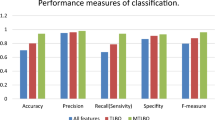Abstract
Rheumatoid arthritis (RA) is a major chronic autoimmune disorder which affects multiple organs and joints of human body. Disease varies in its behavior and concern such that an early prediction is a complex process with regard to time so the diagnosis is not an easy task for the physicians. The common existing methodologies employed to analyze the severity of RA are the clinical, laboratory and physical examinations. The advancement of data mining has been employed for the RA diagnosis through learning from history of datasets. To improve the efficiency and reliability of the approach, this paper presents a hybrid optimization strategy called REACT, which is based on the combination of the features of Iterative Dichotomiser 3 and Particle Swarm Optimization for feature selection and classification of RA. The effectiveness of the proposed diagnosis strategy is validated through its prediction accuracy, specificity, sensitivity, positive predictive value and negative predictive value with existing approaches.



Similar content being viewed by others
References
Bedran Z, Quiroz C, Rosa J, Catoggio LJ, Soriano ER (2013) Validation of a prediction rule for the diagnosis of rheumatoid arthritis in patients with recent onset undifferentiated arthritis. Int J Rheumatol 1:1. https://doi.org/10.1155/2013/548502
Garcia-Zapirain B, Garcia-Chimeno Y (2015) Machine learning techniques for automatic classification of patients with fibromyalgia and arthritis. Int J Comput Trends Technol 25(3):149–152
Lim CK, Yew KM, Ng KH, Abdullah B (2002) A proposed hierarchical fuzzy inference system for the diagnosis of arthritic diseases. Australas Phys Eng Sci Med 25:144–150
Cader MZ, Filer A, Hazlehurst J, de Pablo P, Buckley CD, Raza K (2011) Performance of the 2010 ACR/EULAR criteria for rheumatoid arthritis: comparison with 1987 ACR criteria in a very early synovitis cohort. Ann Rheum Dis. https://doi.org/10.1136/ard.2010.143560
Sangaiah AK, Thangavelu A, Sugumaran V (2017) Computational intelligence applications in business intelligence and big data analytics. Auerbach Publications, Philadelphia. ISBN 9781498761017
Casanova R, Saldana S, Chew EY, Danis RP, Greven CM, Ambrosius WT (2014) Application of random forests methods to diabetic retinopathy classification analyses. PLoS ONE 9(6):e98587. https://doi.org/10.1371/journal.pone.0098587
Debray S et al (1992) Weighted decision trees. In: Proceedings of the joint international conference and symposium on logic programming. MIT Press, pp 654–668
Jafarzadeh SR, Felson DT (2017) Updated estimates suggest a much higher prevalence of arthritis in US adults than previous ones [published online November 27, 2017]. Arthritis Rheumatol. https://doi.org/10.1002/art.40355
He F, Yang HM, Wang G, Cui GD (2012) A novel method for hepatitis disease diagnosis based on RS and PSO. In: Proceedings of International Conference of 4th Electronic System-Integration Technology Conference, pp 1289–1292
Littlestone N, Warmuth MK (1994) The weighted majority algorithm. Inform Comput 108:212–261
Briggs FBS, Ramsay PP (2010) Supervised machine learning and logistic regression identifies novel epistatic risk factors with PTPN22 for rheumatoid arthritis. Genes Immun 11:199–208
Leitich H, Adlassnig K, Kolarz G (1996) Development and evaluation of fuzzy criteria for the diagnosis of rheumatoid. Methods Inf Med 35:334–342
Shiezadeh Z, Sajedi H, Aflakie E (2015) Diagnosis of rheumatoid arthritis using an ensemble learning approach. In: ICAITA, SAI, CDKP, Signal, pp 139–148
Chuang LY, Tsai SW, Yang CH (2011) Improved binary particle swarm optimization using catfish effect for feature selection. Expert Syst Appl 38:12699–12707
Yarnold PR, Soltysik RC (2010) Maximizing accuracy of classification trees by optimal pruning. Optim Data Anal 1:10–22
Singh S, Kumar A, Panneerselvam K, Vennila J (2012) Diagnosis of arthritis through fuzzy inference system. J Med Syst 36:1459–1468
Toussi M, Lamy JB, Le Toumelin P, Venot A (2009) Using data mining techniques to explore physicians’ therapeutic decisions when clinical guidelines do not provide recommendations: methods and example for type 2 diabetes. BMC Med Inform Decis Mak 9:28
Scott IC et al (2013) Predicting the risk of rheumatoid arthritis and its age of onset through modelling genetic risk variants with smoking. PLoS Genet 9(9):e1003808. https://doi.org/10.1371/journal.pgen.1003808
Mohan VK, Ganesan N, Gopalakrishnan R (2014) Association of susceptible genetic markers and autoantibodies in rheumatoid arthritis. J Genet 93(2):597–605
Feng Y, Janeja VP et al (2015) Classifying primary outcomes in rheumatoid arthritis: knowledge discovery from clinical trial metadata. IEEE Trans Inf Technol Biomed 10(2):1–2
Naz R, Ahmad M, Karandikar M (2015) Arthritis prediction by thermal image processing & neural network. IOSR J VLSI Signal Process 5(4):28–34
Louis Bridges S Jr, Kimberly RP (2010) Genetic influences on treatment response in rheumatoid arthritis. Mod Ther Rheum Dis, Totowa
Montejo L (2014) Computational methods for the diagnosis of rheumatoid arthritis with diffuse optical tomography. Doctoral Theses. https://doi.org/10.7916/D8NS0S0C
Chin CY, Weng MY, Lin TC, Cheng SY, Yang YHK, Tseng VS (2015) Mining disease risk patterns from nationwide, clinical databases for the assessment of early rheumatoid arthritis risk. PLoS ONE 10(4):e0122508
McNally E, Keogh C, Galvin R, Fahey T (2014) Diagnostic accuracy of a clinical prediction rule (CPR) for identifying patients with recent-onset undifferentiated arthritis who are at a high risk of developing rheumatoid arthritis: a systematic review and meta-analysis. In: Seminars in Arthritis and Rheumatism, pp 498–507. https://doi.org/10.1016/j.semarthrit.2013.08.005
Quinlan JR (1986) Introduction of decision trees. Mach Learn 1:81. https://doi.org/10.1007/BF00116251
Nair SS, French RM, Laroche D, Thomas E (2014) The application of machine learning algorithms to the analysis of electromyographic patterns from arthritic patients. IEEE Trans Neural Syst Rehabilit Eng 4:1–10
Stilou S, Bamidis PD, Maglaveras N, Pappas C (2001) Mining association rules from clinical databases: an intelligent diagnostic process in healthcare. Stud Health Technol Inform 84:1399–1403
Author information
Authors and Affiliations
Corresponding author
Additional information
Publisher's Note
Springer Nature remains neutral with regard to jurisdictional claims in published maps and institutional affiliations.
Rights and permissions
About this article
Cite this article
Shanmugam, S., Preethi, J. Improved feature selection and classification for rheumatoid arthritis disease using weighted decision tree approach (REACT). J Supercomput 75, 5507–5519 (2019). https://doi.org/10.1007/s11227-019-02800-1
Published:
Issue Date:
DOI: https://doi.org/10.1007/s11227-019-02800-1




